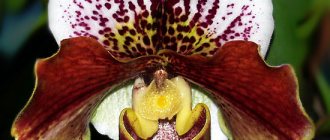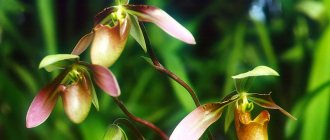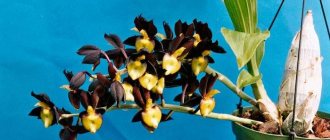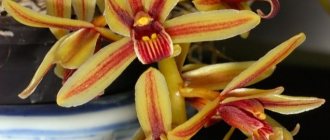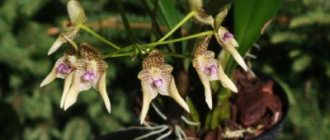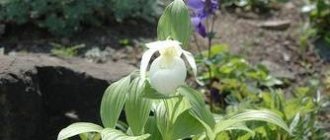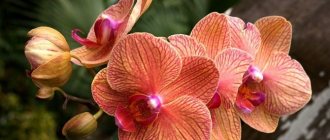A very popular variety of Orchids in Eurasia is the Lady's Slipper (Paphiopedilum), some call it the shaggy orchid (Paphiopedilum naivata). What conditions does this plant prefer? In nature, the Lady's Slipper loves moisture, but not swampy soils.
Moderate light will also be an advantage. As for home conditions, Paphiopedilum is placed in a well-ventilated place , where a sufficient amount of light enters.
Let's take a closer look and find out what the Lady's Slipper orchid (Paphiopedilum) looks like - photo and description of the variety in this article.
Description
A distinctive feature of such an orchid is its flowers , which are shaped very much like a woman’s slipper, which is why they are sometimes called Slipper orchids. The bright colors also attract orchid lovers.
The most common plants are marbled white, light yellow and ash pink.
Less commonly – brown, green and purple. What attracts attention is not the color of the flowers, but the small inclusions on each of them , which can also be of different colors. We must not forget that one rosette forms one peduncle. You can see what the Paphiopedilum shoe orchid looks like in the photo below.
The Lady's Slipper orchid has unusually bright flowers.
It is impossible to resist such beauty; it seems that the plants are from another planet. Previously, all slipper orchids belonged to the genus Cypripedium, and then it was divided into 4 more :
- Cypripedium;
- Paphiopedilum;
- Phragmipedium;
- And selenipedum.
However, when translated into Russian, all four varieties mean the same thing - Venus's slippers .
As for Paphiopedilums, they interbreed well with each other, within the genus. As a result, we have more than 1000 hybrids. Usually the height of the flower is no less than 15 and no more than 25 cm, a distinctive feature is a creeping rhizome.
The Lady's slipper orchid is considered to be a kind of “outcast”. Main habitats :
- Far East;
- Crimea;
- Caucasus;
- Western Siberia;
- and the European part of Russia.
The flower avoids direct sunlight, therefore it grows in shady, warm and dry forests; sometimes you can find the flower on the outskirts of swamps.
IMPORTANT! Some species of Paphiopedilum are able to survive severe cold.
Experienced flower growers say that in order to determine the correct principles of care, you need to obtain information about the original genus from which the acquired hybrid originated.
And if with Phalaenopsis hybrids everything is quite simple, caring for them is absolutely the same, then the Lady’s Slipper requires special treatment.
It is very difficult to determine 100% of the origin of a flower, but for successful flowering it is strictly necessary .
This is the only way to create the most favorable conditions.
Variety of species
There are about a dozen species of Paphiopedilum in stores that sell orchids. Here are the main types of Paphiopedilum:
- Paphiopedilum appletonianum (Appleton's) is a large hybrid up to 40 centimeters high with beautiful and fragrant green-purple flowers. Their diameter reaches 10 centimeters. The marbled pattern is very clearly visible on the leaves; they are belt-shaped. This beautiful orchid usually blooms in spring.
- Paphiopedilum Maudiae (Paphiopedilum Maudi) is the first hybrid that has become very popular among gardeners. The leaves are collected in neat rosettes with a checkered pattern. The flower also has stripes and is large, about 10 centimeters in diameter. It is usually white, but now there are hybrids with wine-red flowers. Its hybrid, Paphiopedilum americana, is also in great demand.
- Paphiopedilum Emerson is a small hybrid up to 20 centimeters high, but with one very large flower, 8 to 11 centimeters in diameter. The lip is orange-yellow, and the lip itself is white. The leaves of this species reach a length of 25 centimeters and are light green.
- Paphiopedilum bellatulum (bellatulum) - was discovered in 1888 in India. Its leaves grow up to 15 cm in length and 5 cm in width. Their lower surface is purple and their upper surface is covered with dark spots. The flowers are large, up to 9 cm in diameter. There can be up to 2 pieces. Usually one. The colors of the flowers range from white to pale yellow. With brownish-purple specks.
- Paphiopedilum niveum has variegated green leaves, the color of their lower surface is burgundy. The peduncle reaches 20 cm in height and one white flower with barely noticeable specks blooms on it.
Orchids with sympodial growth form
The sympoidal shape implies growth in a horizontal direction .
The next season they give new, lateral growth. Pseudobulbs live for about 2-3 years, after which they turn yellow and die. When the pseudobulb reaches its peak of maturity , its upper bud falls off or becomes an inflorescence.
The growth of the pseudobulb ends with the end of the formation of the peduncle , a new sprout is formed at its base and the next annual development cycle begins.
It is quite rare to find such a sympodial type of orchid, in which the arrow shoots out from a bud located at the base of the shoot or at the top of the flower. The leaves of such orchids are quite thin and narrow.
It is this type that needs lower temperatures during the period of flowering stimulation It is also recommended to reduce watering; over the next 8 weeks, the orchid will feed on the moisture that the pseudobulbs have stored.
In order to stimulate the flowering of the Lady's Slipper orchid, you need to lower the temperature in the room.
This type of orchid can be found in nature in areas where heavy rains prevail , which periodically give way to dryness. Such climatic conditions are typical for the tropics.
Of course, it is quite difficult to ensure such periods at home, so rather unpretentious Venus's slippers were developed .
IMPORTANT! Almost all Paphiopedilums sold in flower shops are hybrids that require moderate temperatures and can easily do without a serious dormant period. To grow them, the natural temperature changes that occur with changing seasons are sufficient.
Reviews
Marina. “I first purchased a Lady’s Shoe about five years ago. The only problem we had to face was leaf burn. Therefore, I strongly recommend that everyone protect their plant from direct sunlight, they are detrimental to this plant variety. Paphiopedilums are incredibly beautiful plants that transform any room with their presence and delight guests. They are also suitable for beginners, as the care features are very easy to understand. I recommend!"
Anna. “I can’t imagine my home without orchids. All the window sills are installed, but I want more and more. I recently purchased a Lady’s slipper – an incredibly beautiful flower. If you properly provide the plant with everything it needs: moisture, light, temperature, then flowering is 100% guaranteed. The only thing that’s not very pleasing is the price, and it’s not always easy to find this particular variety in stores.”
Olga. “I’ve been growing Paphiopedilums for quite some time. First of all, I recommend that beginners not be lazy and replant the flower once a year. We all know that tap water is not the cleanest and over the course of a year a sufficient amount of salts accumulate in the root system, which simply destroy the flower. You can stock up on substrate in advance and make it yourself, saving money. Many varieties of orchids do not like replanting, but not Lady’s slipper, they have quite sensitive roots.”
History of origin
This genus of orchids was first studied and described by the English botanist John Lindley in 1737.
Currently, the genus of Slipper orchids includes more than 70 natural species and 1,500 interspecific hybrids of epiphytic, semi-epiphytic and terrestrial orchids located in Southeast Asia.
The greatest species diversity is present on the border of Southern China and Northern Vietnam. In Russia, in the Far East, it is very rare to find the Shoe orchid in the wild.
Breeders have developed many new flower hybrids of the Slipper orchid , which are grown without causing any particular problems.
Transplantation and propagation
Experienced flower growers know that it is not recommended to subject an orchid to stress , however, in order for the paphiopedilum to develop painlessly, it should be replanted once a year. This applies primarily to young plants; adult specimens need to be replanted every 2 years.
Basic rules for transplantation:
- Mature plants should be replanted in case the pot becomes too small for further growth and development of the orchid;
Adult orchids should be replanted only as needed. - Transplantation is carried out only after flowering , the best period is spring;
- Slippers reproduce only by division . Another possible method is seeds, but it will take at least 3 years for new flowers to grow. This orchid variety does not reproduce by other vegetative methods;
- The new pot should be at least 5 centimeters larger than the previous one;
- The replanting process begins with the prepared drainage being poured into the pot , then the substrate needs to be added. The plant must be protected from exposure to sunlight, the substrate must be kept moist, and it is recommended to water the flower only when necessary;
- After the transplant, 2-3 weeks later, when the shoe has already taken root and taken root, you should return to the usual regime of caring for the orchid.
Mr. Summer Resident informs: paphiopedilum - medicinal properties, use and contraindications
In the industry of alternative treatment, lady's slipper is widely used to get rid of a variety of diseases. Most often, medications with the addition of paphiopedilum are used to relieve insomnia and migraines. In addition, decoctions from this flower can cure epileptic seizures and improve appetite.
Orchid-based products guarantee the following effect:
- laxative;
- exciting;
- painkiller;
- sedative.
Decoctions from the flower are used for uterine bleeding, heart and vascular diseases, and hepatitis. Remedies from the large-flowered slipper species deserve special attention:
- Infusion for the treatment of gynecological diseases. One fresh plant is poured with 300 ml of boiling water and infused for several hours. The resulting product is used throughout the day. It is allowed to drink it after childbirth, since the medicine has a blood purifying effect.
- Depressant. A teaspoon of the dried plant is poured into a thermos and filled with a glass of boiling water. The product is infused, filtered, after which it is ready for use. It is recommended to take in the presence of neurological diseases.
- Diuretic infusion. Add a teaspoon of crushed plant to 200 ml of boiling water. The product is infused, filtered, and then consumed in a volume of 1 tbsp. spoons after meals.
- A decoction for colds. 5 g of dried flowers are poured into 200 ml of boiling water. The product is cooked for 5-10 minutes over low heat, cooled and filtered. Take 5 ml before meals.
But, despite such a number of positive properties of the lady's slipper, preparations with the addition of this plant are strictly forbidden to be used during pregnancy and lactation. In addition, it should be remembered that paphiopedilum contains many alkaloids, which have a toxic effect and, if dosages are not observed, can cause serious poisoning.
Conditions of detention
Watering
Flower growers strongly recommend that beginners protect their shoes from direct sunlight . Otherwise, the leaves will quickly lose their appearance and fade.
There is an interesting folk remedy for bright and beautiful leaves - you just need to wipe them once a month with water in which sugar is dissolved or with regular beer.
An important feature of the leaves of the Lady's Slipper orchid is the ability to determine from them what the plant needs at the moment . If the leaves are wrinkled, this is the first sign that the root system is in trouble.
If the roots of Paphiopedilum have become unusable, this means that the orchid does not receive the required amount of moisture and nutrients .
IMPORTANT! Experts recommend that if you suspect that there is a problem with the root system, you should carefully shake the shoe out of the substrate and carefully inspect the root system.
The healthy roots of Paphiopedilum differ from other orchid varieties. First of all, in color - they have a light brown tint with small fibers. Roots are a universal part of an orchid; they can also be used to determine the phase in which your pet is currently located.
The main reasons for the death of roots are waterlogging or, conversely , lack of moisture. It is recommended to water with settled water at room temperature.
If the root system has come to an end, the first step is to replant the plant in a fresh substrate. When replanting, you should first get rid of dead roots.
The soil
substrate for Paphiopedilum :
- The main part is finely chopped pine bark;
- Dried pieces of moss (preferably sphagnum);
- Fine charcoal;
- Fern roots (optional).
The best soil for orchids is pine bark.
These components are moisture-absorbent , which is excellent for the root system of this orchid. The main advantage of such a substrate is that the elements included in its composition can be obtained with one’s own hands in the nearest pine forest. It is best to do this in the spring.
The best bark to collect is the one that lies around the tree. It should not be very thin . Sphagnum moss can be found in swampy areas. This moss does an excellent job of retaining moisture.
The easiest task is to find charcoal . To do this, just break the charred log and voila - another ingredient for the substrate is ready. As for fern roots, they are used only in dried form and collected in the summer. It is recommended to take care of the preparations in advance.
Temperature
All Paphiopedilums are divided into 2 main categories: heat-loving and cold-loving. It’s quite simple to figure out what type of tropical beauty lives on your windowsill :
- Lady's slippers, which boast variegated leaves, prefer warmth;
- While green oblong leaves are a sign that the orchid prefers cool weather.
Sometimes you can find hybrids that are in dire need of lower temperatures, for the so-called cold wintering. Only lowering the night temperature to 10 degrees can stimulate orchid flowering. For typical representatives, the optimal temperature is 18-25 degrees.
IMPORTANT! An increase in temperature to 35 degrees can lead to the death of the plant.
Lighting
The most important rule when organizing lighting for Paphiopedilums is to minimize the risk of direct sunlight . It is best to find a place in the house where there is shadow.
Often, ardent fans of orchids have all the places on their windowsills occupied. If for some reason the plants do not receive natural light, experienced gardeners recommend using artificial lighting , including lamps.
It is recommended to turn on artificial light for at least 10 hours.
Fertilizer
It is recommended to fertilize the plant during the period of active growth . It is strictly necessary to alternate organic fertilizers with mineral ones.
You should treat fertilizers carefully and not overdo it, because the Lady's Slipper reacts quite negatively to an excess of fertilizing , which leads to death. In order to prevent such an outcome, the orchid should be replanted approximately once a year.
Prevention of various problems
- Insect prevention should be carried out at home. Every spring and autumn, it is necessary to spray the plants with insecticides. A simple way to avoid such unpleasant “guests” is to wipe the Shoe with green soap and maintain constant air humidity. If you need more serious remedies, then karbofos, Fozalon, or Actellik solution will help.
- Maintain sterility during transplantation to prevent infection by fungi and viruses.
- To prevent root rotting, avoid excessive watering. If the plant is sick and the roots have rotted, they dig it up and remove the problem area.
If you follow the recommendations for caring for Venus's slippers, they will delight us with their beauty and elegance for a long time.
Bloom
Proper care involves the annual flowering of the Lady's Slipper. Most often this period occurs in autumn-winter. It is very simple to determine that a flower is fully prepared and will soon begin to delight with inflorescences - a stop leaf appears from the growing point.
in size than standard leaves and usually does not grow further. This means that the orchid will soon begin to actively bloom.
This moment is inevitable if all recommendations were taken into account when growing an orchid and favorable conditions were provided throughout the year. When the stop leaf becomes compacted, a bud appears from it.
IMPORTANT! During the flowering period, the orchid must not be disturbed, especially moved to another place. After all, if a plant begins to bloom, then the conditions for this are quite favorable and any changes can only do harm.
Usually, the Lady's Slipper does not hibernate, but after flowering it still needs a short rest . To do this, lower the temperature slightly (15-18 degrees) and reduce the flow of moisture.
As soon as the plant begins to delight with a new bud, the rest period is over and now the previous conditions , that is, raise the temperature, resume watering and fertilizing.
Interesting Facts
- It turns out that orchid seeds germinate only thanks to special fungi that naturally penetrate the tissues of the embryo;
- If other varieties of orchids can begin to bloom 2-3 years after germination of the seed, then the Lady's slipper may take as long as 15 years;
- It has protective functions , for example, it is saved from being eaten by animals by poisonous juice;
- Venus's slippers are long-lived and can grow for even 100 years!
- In 1984 they were listed in the Red Book of the USSR.
General information
In our latitudes I use more familiar names: Mary's shoe, Virgin's boots, cuckoo's shoes, Adam's head, cockerels, lady's shoes and even moccasins. It was no coincidence that people called it that way. Have you seen how this plant blooms? The shape of the flower is very similar to a shoe with ties.
Legend
Where did such a beautiful name come from, Lady's Slipper? An old myth tells us about the Hellenic goddess of love, Aphrodite. Her other names: Venus, Cypris. Walking with the beautiful god Adonis through the forest, we hid from the rain high in the foliage of the trees. Venus took off her wet shoes, and one slipped right under the feet of a random traveler. He wanted to pick up the golden beauty, but as soon as he touched it, the shoe took on the appearance of an amazing flower. From that very moment, everyone who has ever seen a Paphiopedilum orchid flower remembers the barefoot goddess.
Spreading
The lady's slipper will be born over a wide area. These beauties are found in the forests of North America and Eurasia. Traces of them can be found in Mongolia, Thailand, China, Japan, and Nepal. These flowers are found only in hot deserts and in the far north.
Description
Let's take a closer look at this amazing creation.
- - a powerful rhizome located horizontally close to the surface. This allows the flower to survive in any weather.
- – the stem is usually short (15-20 cm), but there are also tall ones (up to 60 cm)
- – there are aerial roots
- – the leaves are elliptical in shape and dense. Length from 5 to 60 cm.
The color of the leaves is either solid dark green or marble. There is usually one peduncle in a rosette of leaves. Its length is from 4 to 60 cm. Flowers can be single or collected in inflorescences. Sometimes 30 flowers. Their diameter varies from a small one of 4 centimeters to a large one of 60 centimeters. The shoe can take on all sorts of colors: from snow-white to dark brown with splashes.
This orchid reproduces by seeds or vegetatively (by dividing the bush). Bright colors and unique aroma attract insects. They climb deep inside the flower, from where they can only get out through a small hole located on the far wall of the flower. In this way it is pollinated. Afterwards, the flower quickly fades.
INTERESTING. The very beginning of a flower's life cycle is directly related to the fungi that are present in the soil. Once inside the seed, the mushrooms help it germinate. Such mutual assistance is beneficial to both the plant and the mushroom itself. The seeds ripen by the end of summer. The seedling will spend the first three years underground.
